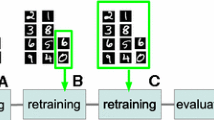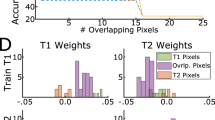Abstract
Model-based learning systems such as neural networks usually “forget” learned skills due to incremental learning of new instances. This is because the modification of a parameter interferes with old memories. Therefore, to avoid forgetting, incremental learning processes in these learning systems must include relearning of old instances. The relearning process, however, is time-consuming. We present two types of incremental learning method designed to achieve quick adaptation with low resources. One approach is to use a sleep phase to provide time for learning. The other one involves a “meta-learning module” that acquires learning skills through experience. The system carries out “reactive modification” of parameters not only to memorize new instances, but also to avoid forgetting old memories using a meta-learning module.
Similar content being viewed by others
References
DC Park MA El-Sharkawi SuffixII RJ Marks (1991) ArticleTitleAn adaptively trained neural network IEEE Trans Neural Networks 2 IssueID3 334–345 Occurrence Handle10.1109/72.97910
C Jutten R Chentouf (1995) ArticleTitleA new scheme for incremental learning Neural Process Lett 2 IssueID1 1–4
T Yoneda M Yamanaka Y Kakazu (1992) ArticleTitleStudy on optimization of grinding conditions using neural networks – a method of additional learning J Jpn Soc Precision Eng Seimitsu Kogakukaishi 58 IssueID10 1707–1712
Yamakawa H, Masumoto D, Kimoto T, et al. (1994) Active data selection and subsequent revision for sequential learning with neural networks. World Congress of Neural Networks (WCNN’94), vol 3, pp 661–666
K Yamauchi N Yamaguchi N Ishii (1999) ArticleTitleIncremental learning methods with retrieving interfered patterns IEEE Trans Neural Networks 10 IssueID6 1351–1365 Occurrence Handle10.1109/72.809080
Fahlman SE, Lebiere C (1990) The cascade-correlation learning architecture. In: Touretzky DS (ed) Advances in neural information processing systems 2. Morgan Kaufmann, pp 524–532
LM Fu H-H Hsu JC Principe (1996) ArticleTitleIncremental backpropagation learning networks IEEE Trans Neural Networks 7 IssueID3 757–761 Occurrence Handle10.1109/72.501732
Yamauchi K (2003). Incremental learning with sleep application for predicting posterior distribution. International Joint Conference on Neural Networks, IJCNN2003, vol 4, pp 2776–2781
YW Lu N Sundararajan P Saratchandran (1997) ArticleTitleA sequential learning scheme for function approximation using minimal radial basis function neural networks Neural Comput 9 461–478 Occurrence Handle9117909
J Platt (1991) ArticleTitleA resource allocating network for function interpolation Neural Comput 3 IssueID2 213–225
Oohira T, Yamauchi K, Omori T (2003) Meta-learning for fast incremental learning. In: Kaynak O, Alpaydin E, Oja E, Xu L (eds) ICANN/ICONIP 2003 LNCS2714, Springer, pp 157–164
Author information
Authors and Affiliations
Corresponding author
Additional information
This work was presented, in part, at the 9th International Symposium on Artificial Life and Robotics, Oita, Japan, January 28–30, 2004
About this article
Cite this article
Yamauchi, K., Oohira, T. & Omori, T. Fast incremental learning methods inspired by biological learning behavior. Artif Life Robotics 9, 128–134 (2005). https://doi.org/10.1007/s10015-004-0325-5
Received:
Accepted:
Issue Date:
DOI: https://doi.org/10.1007/s10015-004-0325-5




